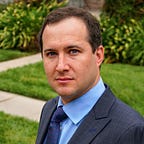There’s Something Wrong with the Library’s Image
It’s not all books and shelves at the Library!
Reading articles about libraries on a near-daily basis, I can’t help but notice that the images most often chosen to represent libraries are a shelf of books.
Here’s a similar photo, but taken at an artistic angle:
Occasionally there’s even a person, but unless the article is about the new town librarian, they’re anonymous:
Don’t misunderstand, there’s nothing wrong with books, or libraries having books — I love books. What I don’t love is that these images of books and bookshelves represent the limited way in which the media thinks about libraries even when they specifically say otherwise. For example, check out this 2014 article from Smithsonian Magazine, entitled “Libraries Are Great at Lending All Sorts of Things — Not Just Books” and this 2017 In the Bay piece called “Public Libraries: More Than Just a Book Lending Service.” Both of these delightful articles about how libraries are more than books lead with images of, yes, you guessed it, bookshelves! It makes no sense, but it happens all the time!
So what type of photos should media outlets use to represent libraries? Well, to start how about some more active images — pictures of people doing something. Nobody comes to the library and turns into a bookshelf, library patrons do things — sometimes important things — at their local library! Here are some examples:
You’ll notice the variety of activities happening in these images, and I needn’t point out that they’re not at all unusual. Storytime happens on a weekly, if not daily, basis at most libraries. Computer classes and clubs are ubiquitous at libraries (I used to run a weekly drop-in coding workshop at my library back in 2012–13). Research assistance has been a traditional library practice since well before the formation of public libraries, as have library concerts, often with an accompanying lecture. The point is, that there shouldn’t be any hesitation in using photos like this to represent libraries.
It is a fact that libraries are places where ideas are born and grow. Sometimes, that starts with an e-book checked out from the library website:
Other times, ideas and learning are nurtured in collaboration with others. At a book club:
Or study group:
Or a library program, with a bunch of your peers, and the odd snake:
Not everything that happens at the library is as raucous as a program on desert animals, however. I’ve written before about how libraries benefit health and well-being by allowing visitors to slow down and think. Slow Information (or slow info) means taking one’s time and focusing, curtailing the rate of new stimuli, and easing into an experience. Few things are more in tune with that category than classes on yoga and meditation, which occur at many a library across the country including the San José Public Library:
But slow info is most often exemplified by solitary activities, such as reading:
Studying:
Thinking:
There are so many images not centering on bookshelves that can be used to represent libraries. How about something related to co-working? Learning job skills? Searching for work? Business development? Libraries as centers for creativity? Library makerspaces? Literacy training? Or an image highlighting the library’s deep and engaging digital resources? Sure, it means taking a few more minutes to select the right photo. But isn’t a picture worth a thousand words?
Libraries are a complex institution that serve all of society no matter what age, ethnicity, gender, or socioeconomic level a person is. Books support what libraries do, but they do not define what a library is. Let’s all do better at articulating our library’s vast and vital functions via how vividly we visually represent them!
